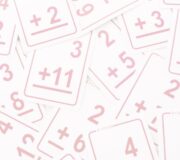25 Division Word Problems for Grades 3 to 5 With Tips On Supporting Students’ Progress
Division word problems are important in building proficiency in division. Division is one of the bedrocks of math alongside addition, subtraction and multiplication. Therefore, it is vital that students have a deep understanding of division, its function within arithmetic and word problems, and how to apply both short division and long division with success.
Division itself is the mathematical process of breaking a number up into equal parts and then finding out how many equal parts you can have. It may be that you have a remainder following the division or you may have no remainder and so a whole number as your answer.
What are division word problems?
Division word problems are an extension of the arithmetic method whereby they are word problems with division at the heart. Students will be expected to use the process of division to find a solution to the word problem.
Typically, word problems use a story as a scenario and are based on a real life situation where students are expected to interpret what the word problem is asking and then apply their division knowledge to find the answer. Division can also be introduced early through the idea of grouping before advancing to the formal method of long division.
To help you with the division journey, we have put together a collection of division word problems which can be used for children between 3rd grade to 5th grade.
Word Problems Grade 4 Fractions and Decimals
Download grade 4 fractions and decimals word problems to develop your students' reasoning and problem solving skills. Includes 11 questions and answers!
Download Free Now!Division word problems in upper elementary
As children enter 3rd grade, they begin to develop their mental and written strategies for division. Students will begin to use their multiplication knowledge and times tables to assist in their solving of division problems and how they can use the corresponding division facts and multiplication facts to answer questions.
By the end of 3rd grade, students are expected to recall their multiplication and division facts for multiplication times tables up to 10 x 10. They should also use their knowledge of place value, and known and derived facts to assist with simple division such as dividing by 1 and halving.
Introducing partial quotients
Before being introduced to the standard algorithm, also known as long division, students learn the partial quotients method. Students practice their fluency of short division, in order to answer division word problems that have a whole number answer, and those with a remainder.
Before entering 4th and 5th grade, students encounter division word problems and multi step problems with increasingly harder numbers going from a simple division problem, such as, ‘If we have 30 students in our class and we are divided into groups of 5, how many students will be in each group?’ to ‘If there are 56 books in our library and they are shared among 7 children, how many books would each child get?
Introducing standard algorithm division
As our students enter 5th grade, the standard algorithm, or long division, is introduced. By the end of 5th grade, students should be fluent in both multiplication and division and the written strategies, and be able to apply knowledge in fraction word problems.
4th grade students work towards being able to divide up to 4 digit numbers by a one digit number using partial quotients and being able to interpret remainders in the correct context – even presenting the remainder as a decimal or fraction. Students should also be able to divide mentally and know how to divide by 10, 100 and 1,000 and how place value works alongside dividing a number so it is 10, 100 or 1,000 times smaller.
5th grade students are expected to consolidate on the above formal methods of division before being able to divide a four digit number by a two digit number using the formal method of standard algorithm division and to again be able to understand remainders within this and present them in the correct context.
This also flows into division word problems as children should be able to read a multi step problem and know how to correctly interpret it, apply their divisional knowledge and solve the problem successfully. The concept of multi step problems is built upon at each stage of your state math curriculum.
Why are word problems important for childrens’ understanding of division?
Word problems, alongside the use of concrete objects and visual representations, are important in helping children understand the complexities and possible abstract nature of division.
While children may understand that when we divide our answer will be smaller, before providing a child with word problem worksheets, just like with exploring arrays to support multiplication word problems, it is important to visually explore how division looks – from grouping and beyond.
Applying math to real life situations
Word problems are important because they provide a real life context for children to understand division and how we encounter it in real life. By allowing children to see how division is used in everyday situations, children will find it more meaningful and relevant which in turn develops a deeper understanding of the four operations as a whole.
Building problem solving skills
Word problems are also vital to developing problem solving skills. First, they must read and understand the problem before being able to identify the relevant information within the contextual problem and apply their knowledge to find a solution. This naturally builds critical thinking and a child’s ability to reason, which is an important skill for any mathematician.
Developing mathematical language skills
Finally, the importance of moving from simple division word problems to more challenging ones enhances students’ vocabulary and language skills. For children to develop an understanding of vocabulary such as divisors, quotient and remainders means they must first understand these key words and apply it to the process of division and be able to communicate clearly what they are aiming to do.
Deepening understanding of the inverse relationship between division and multiplication
Division word problems also solidify the connection between multiplication and division. Understanding these inverse operations and being able to interchange the skills of multiplication and division will help make connections between different mathematical concepts and deepen students’ learning.
How to teach division word problem solving in elementary school.
Having taught the concept of division to students using concrete examples, for example how to group or share counters and cubes, the next step is to advance to division word problems.
As with all word problems, it is important that students are able to read the question carefully and interpret it so they know what they are being asked. Do they need to add, subtract, multiply or divide? Are they solving a multi step problem and need to do more than one step? They may decide what operation to do, in this blogs’ case – division, and then choose to represent it visually.
Example of a division word problem
There are 40 pieces of candy ready to go in the party bags for Laura’s birthday. They are to be shared between 8 friends. How many pieces of candy will each child get?
How to solve this:
First, we need to interpret the question. Laura has invited 8 friends to her party and she has 40 pieces of candy to share equally between her friends. So we know:
- There are 40 pieces of candy in total
- They are to be divided among 8 friends in total
- We will need to divide the total number of candies (40) by the number of friends (8). To solve this problem we could put the total number of candies (the dividend – 40 ) using the partial quotient method and divide by the total number of friends (the divisor – 8). If we do this, we would get the answer of 5 – the quotient. Each friend would get 5 pieces of candy each as 40 divided by 8 is 5.
- Alternatively, we could use the inverse – multiplication – to solve this problem. We may not know the division fact that 40 divided by 8 = 5 but if we look to the inverse we may know what number multiplied by 8 equals 40. If we did our 8 times table we would get the answer of 5 – the correct answer.
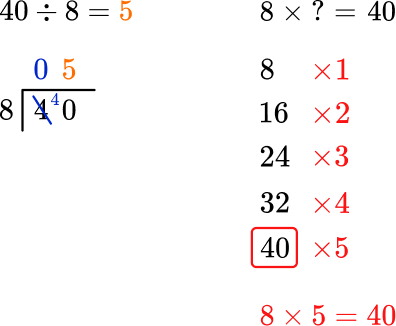
How can we show this visually?
We could show 8 circles – each circle to represent a child – and place a piece of candy in each circle until we have placed all 40 candies. This would mean we have shared the candies equally between the friends and would result in each child having 5 candies.
We could represent the division word problem as a bar model. We could split the bar model into 8 sections. There are 40 candies and so we share them between the 8 sections. We will see that each section will get 5 pieces of candy.
The below visuals show how this would look:
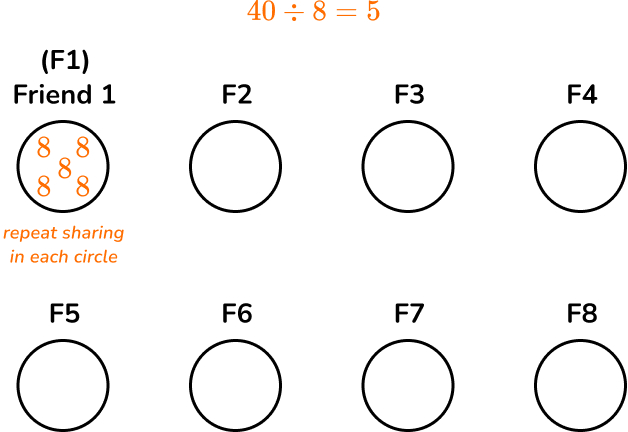
Or:
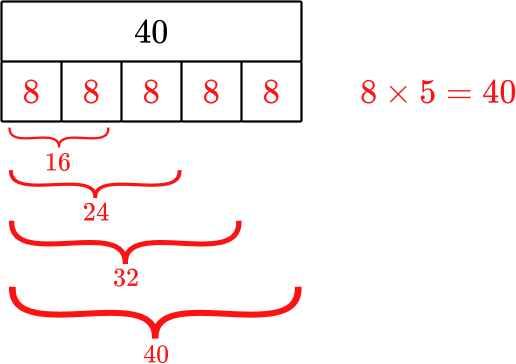
Word problems are an important aspect of our learning at Third Space Learning’s one-to-one tutoring program. Tutors will work with our tutees to break down the word problems and identify the correct operation needed to solve the word problem.
Examples of division word problems in the elementary setting
Below are examples of what can be expected at each year group from grades 3 to 5. Through our tutoring program at Third Space Learning, our tutees will become familiar with word problems throughout their learning. They will encounter word problems on a regular basis with each lesson personalized to develop the learning our tutees need. The word problems will increase their confidence, familiarity with vocabulary and mathematical understanding.
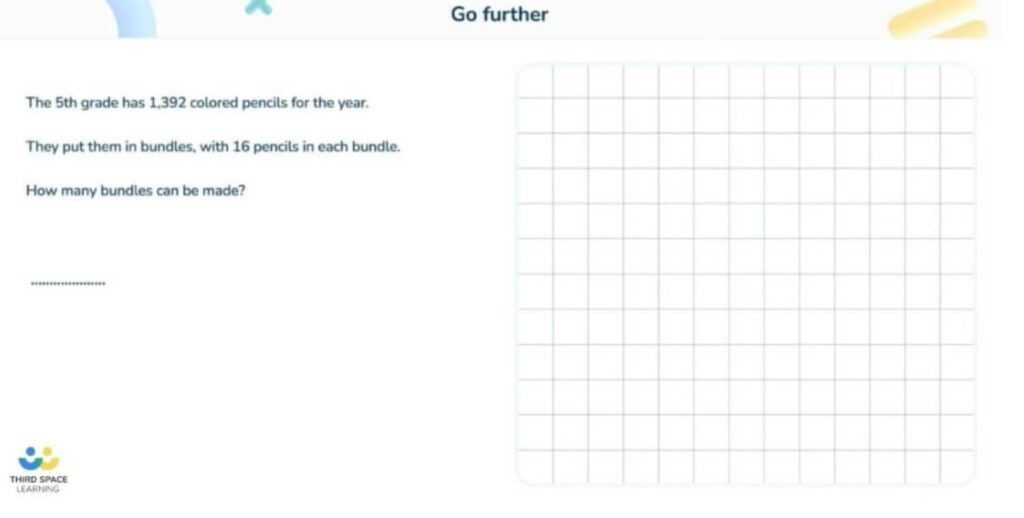
Division word problems are essential to developing problem solving skills and mathematical reasoning.
3rd grade division word problems
Word problems for 3rd grade, students should begin using their recall of the times table facts they have learned to help with division word problems and be able to divide two digit numbers by one digit numbers using mental and partial quotients. Word problems may also involve multi step problems.
Question 1:
If a school has 90 students in 2nd grade and there are 3 classes in 2nd grade, how many students are in each class?
Answer: 30
90 shared equally into 3 classes = 30 children per class
Question 2:
Every day a school gets a delivery of milk in a crate. There are 96 cartons of milk in the crate. If there are 8 milk cartons in a pack, how many packs will be in the crate?
Answer: 8
96 divided by 12 = 8.
There are 8 cartons of milk in a pack.
Question 3:
A delivery of 96 footballs arrives at school for sports day. They are to be shared equally between 4 classes. How many footballs does each class get?
Answer: 24
96 divided by 4 = 24 footballs per class
Question 4:
3rd grade is going to the beach on a school trip. If there are 100 children in 3rd grade and only 10 children can go on one mini bus, how many mini buses does Mr. Pearson need to book?
Answer: 10
100 children divided 10 = 10 mini buses.
Question 5:
If you have 60 flowers and divide them into four flower pots, how many flowers are in each pot? Are there any left over?
Answer: 15 flowers in each pot.
If we divide 60 into 4 equal groups then we can use the partial quotient method.
When using the partial quotients method, students rely on what multiplication facts they can use.
Because we are dividing 60 by 4, we may ask ourselves, what number can I multiply 4 by, to get close to 60 without going over? Students should be familiar with their 10s time tables, and 4 x 10 = 40. We place the 10 above the quotient line, and then subtract 40 from 60, leaving 20 remaining.
We will now start the process all over again. What number can I multiply 4 by to get close to 20 without going over? We know that 4 x 5 = 20, so again, place 5 above the 10 in the quotient line and subtract 20 – 20. Because there is nothing left over, we are done dividing.
So the answer to 60 divided by 4 = 15.
This would look like:
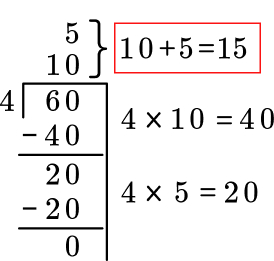
4th grade division word problems
Word problems for 4th grade center around dividing a 4 digit number by a 1 digit number using the partial products method or area model method of division. They will also be introduced to remainders and be expected to interpret remainders correctly depending on the context.
Question 1:
Ronan has a ball of string that is 819 cm long. He cuts it into 7 equal pieces. How long is 1 piece of string?
Answer: 117cm
819 divided by 7 = 117
Question 2:
In upper elementary there are 1,248 colored pencils. If there are 6 classes in upper elementary, how many pencils would each class receive?
Answer: 208
We use the division method to divide 1,248 by 6 and we get 208 as the result.
Question 3:
Mia buys three computer games for $84. How much is one computer game?
Answer: $28.
We divide $84.00 by 3 and we get $28.00.
Question 4:
The area of the school hall is 1,704m and needs to be split into four quadrants. What would be the area of each quadrant?
Answer: 426m
We take the total area of the school and divide it by 4 to represent each quadrant. In doing so, we would have 426m for each quadrant.
To check this is the correct answer, we could do the inverse and multiply 426 by 4 and we would get 1,704m.
Question 5:
Packets of candy are put into multi packs of 4. Today, 7,800 packets of candy were packed. How many boxes of candy were packed?
Answer: 163 boxes
We then have to take the total packets of candy– 7,800 – and divide this by 4. If we do this we will get the answer 1,950 boxes were packed.
5th grade division word problems
Word problems for 5th grade will be preparing for the end of elementary school. They would be familiar with the concept of standard algorithm division and needing to divide a 4 digit number by a 2 digit number using the formal method of standard algorithm division.
Question 1:
A school is selling tickets at $6 each to attend the Big Christmas Fair. Over 15 weeks it has earned an amazing $9,720! On average, how many tickets were sold each week?
Answer: 108 tickets per week
First, we need to use the formal method of standard algorithm division to divide the grand total – $9,720 by 15. If we do this correctly we will have the answer 648.
Then, we need to take this answer of 648, which is how much is earned each week, and then divide this by $6, the amount each ticket is.
This will result in the number of tickets sold each week – 108 tickets.
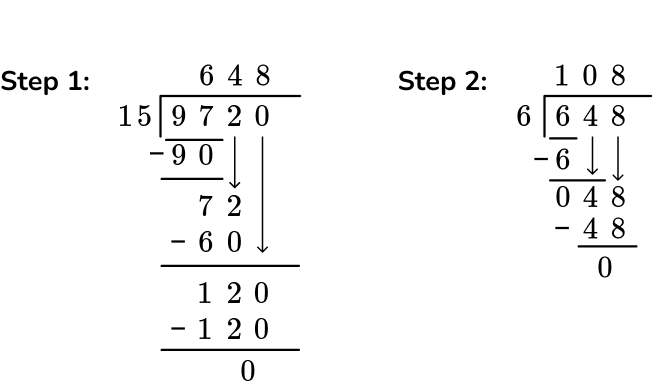
Question 2:
A square sports field has a perimeter of 2.696km. How long is each side of the field?
Answer: 674m
To answer this we need to be able to convert the 2.696km into meters. There are 1000 meters in a kilometer so that would be 2,696m. Then we divide this by 4 and get 674m for one side.
Question 3:
Keira is given a toy blocks kit containing 2,208 individual blocks. She wants to split the toy blocks evenly between 15 friends and herself to work on making a toy block city together. How many blocks should she give each of her friends?
Answer: 138 blocks
We need to use the formal method of standard algorithm division to solve this. We also need to ensure we include Keira and her 15 friends so we have the number 16 as the divisor.
When we divide 2,208 by 16 using long division we get the answer 138.
Question 4:
Wesleigh was running in the cross country race. He ran for a distance of 3,569m and it took him 11 minutes to complete the race. How many meters did he run per minute? Give your answer to the nearest whole meter.
Answer: 324 meters
We need to use standard algorithm division to divide 3,569 by 11. That will give us an answer of 324.45. As the decimal can be rounded down, the answer is 324 meters.
Question 5:
Sophia is preparing her candy stall for the fair. She can fit 18 tins of candy into one crate. How many crates will be needed to fit 153 tins of candy?
Answer: 9 crates
We divide 153 by 18 using standard algorithm division and we have an answer of 8, remainder 5. Therefore, having 8 crates would not be enough as we would have 85 tins left over and so we need a further tin to house the 5 tins left over. So, 9 crates are needed.
More word problems resources
Are you looking for more word problems resources? Take a look at our library of word problems practice questions including: time word problems, ratio word problems, addition word problems and subtraction word problems.
Do you have students who need extra support in math?
Give your students more opportunities to consolidate learning and practice skills through personalized math tutoring with their own dedicated online math tutor.
Each student receives differentiated instruction designed to close their individual learning gaps, and scaffolded learning ensures every student learns at the right pace. Lessons are aligned with your state’s standards and assessments, plus you’ll receive regular reports every step of the way.
Personalized one-on-one math tutoring programs are available for:
– 2nd grade tutoring
– 3rd grade tutoring
– 4th grade tutoring
– 5th grade tutoring
– 6th grade tutoring
– 7th grade tutoring
– 8th grade tutoring
Why not learn more about how it works?
The content in this article was originally written by former Deputy Headteacher Steven Eastes and has since been revised and adapted for US schools by elementary math teacher Christi Kulesza.


